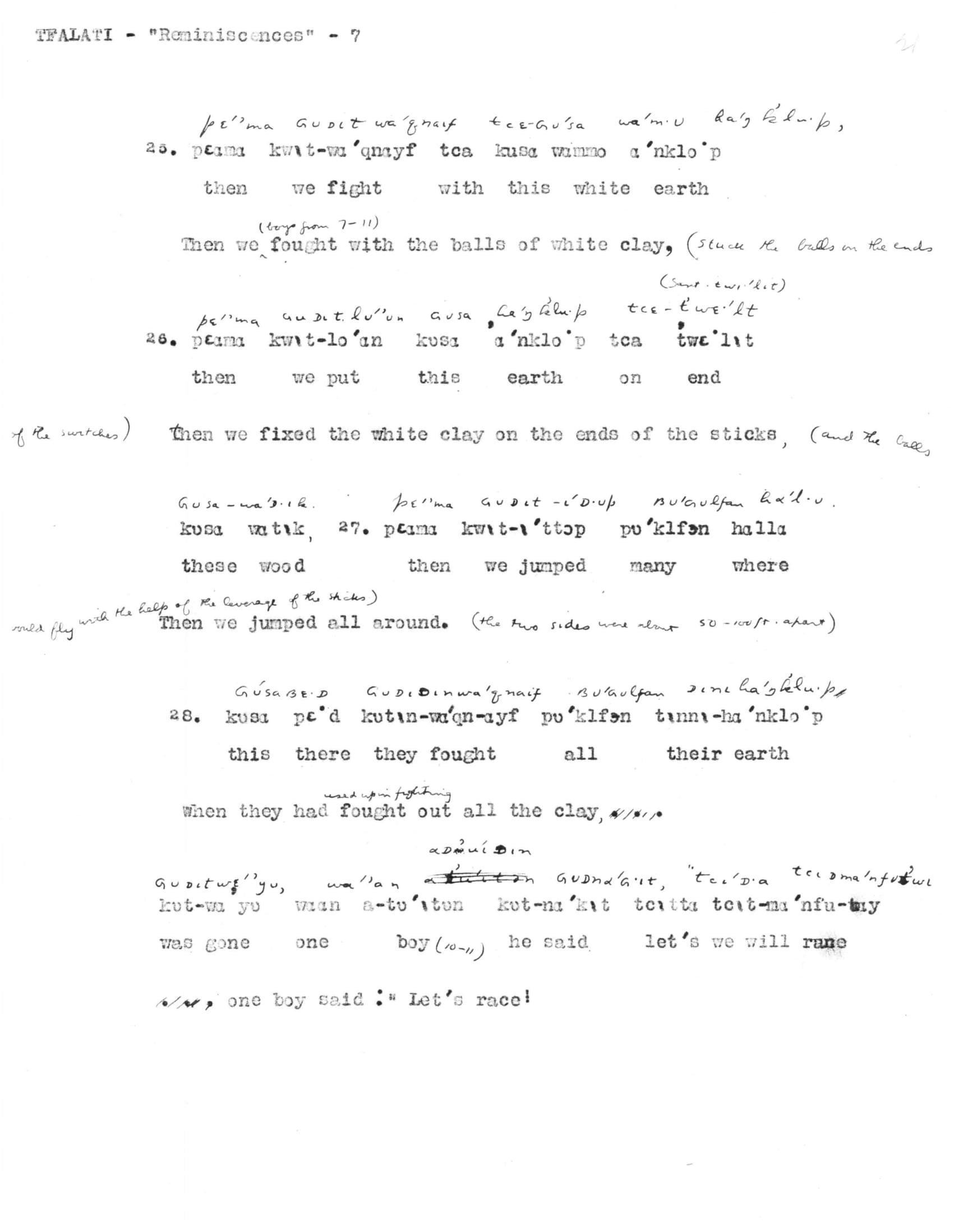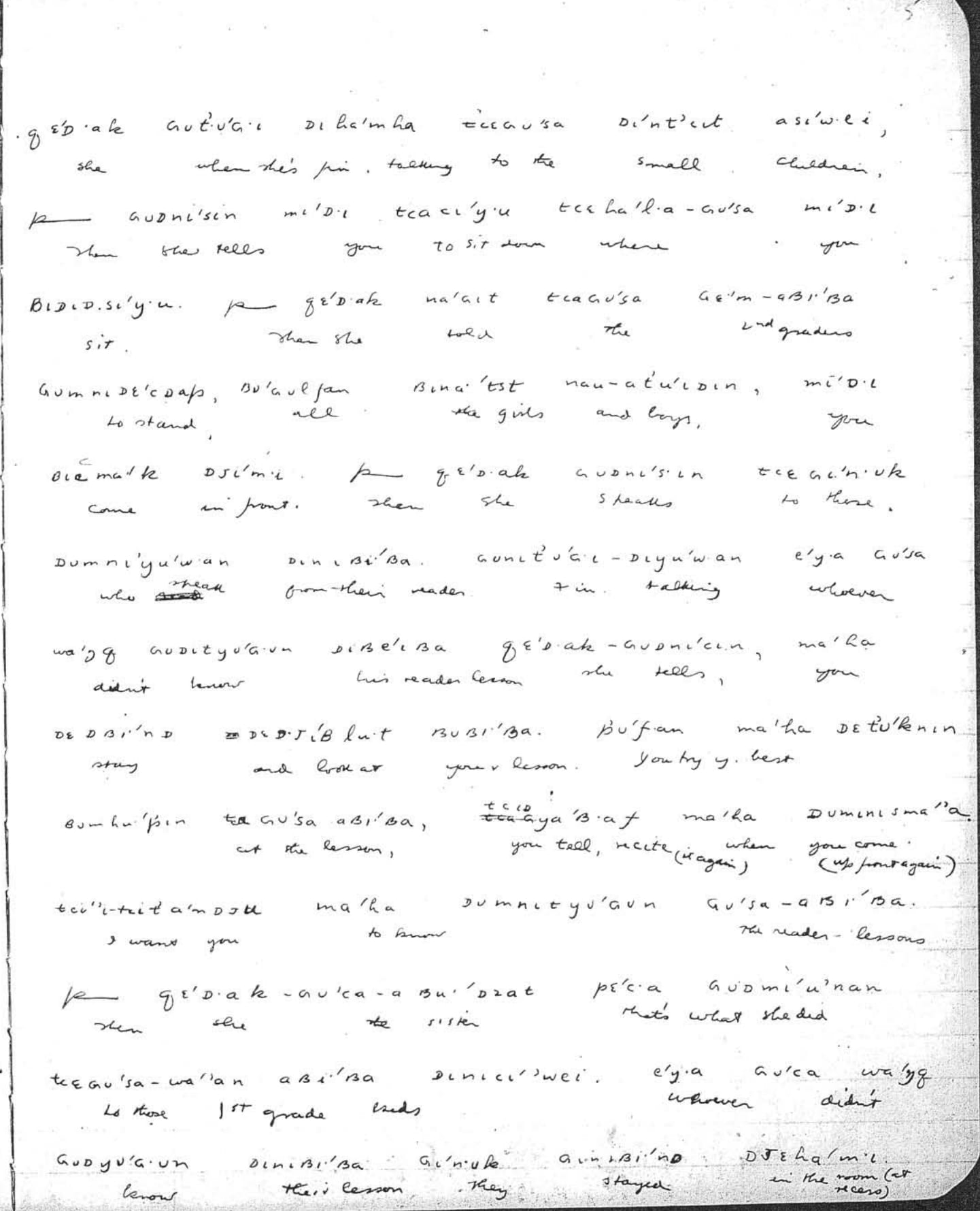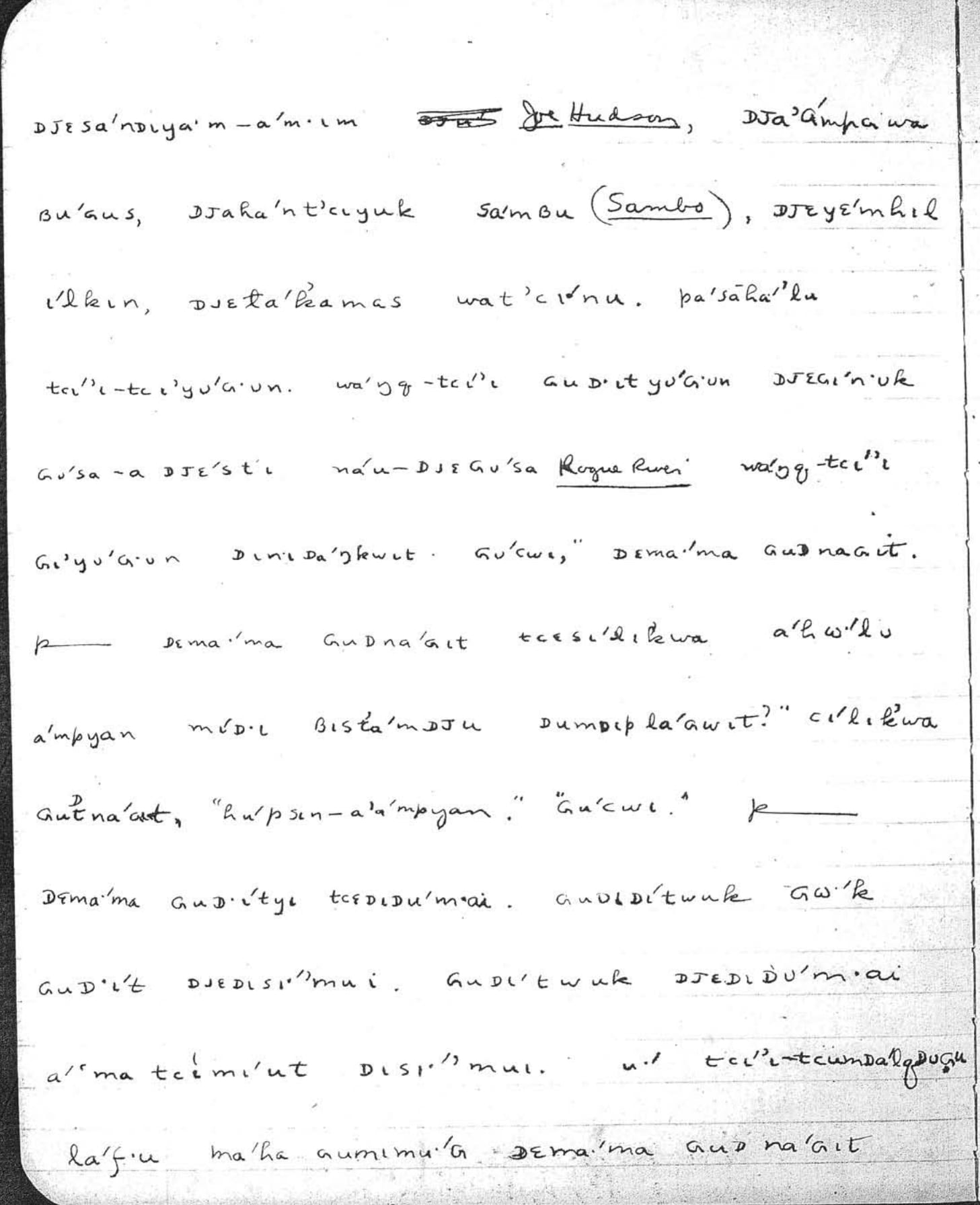Henry
Zenk, co-translator with Jedd Schrock of My Life, by Louis Kenoyer: Reminiscences of
a Grand Ronde Reservation Childhood, is here to explain the complicated
and painstaking process he and Jedd Schrock undertook when translating the reminiscences
left by Louis Kenoyer. Kenoyer was the last known speaker of Tualatin Northern
Kalapuya, the language in which he dictated his memoir, describing life and
recounting his childhood o n the Grand Ronde Reservation in Oregon in
the late 19th Century. Zenk
and Schrock were confronted with what many may have found to be an overwhelming
obstacle: the linguists whose manuscripts they worked from left them with an incompletely translated text, but did not provide them with a usable description of the language’s
grammar. The illustrations below sample the record left by the three linguists whose manuscripts Zenk and Schrock worked from: first, a typescript-page with interlinear and free translations; next, a field-notebook page with field translation; and finally, a field-notebook page minus translation.
----------------------
The subject
matter of My Life, by Louis Kenoyer is
a long autobiographical narrative told in Tualatin Northern Kalapuya, the
indigenous language of one of the founding tribes of the Grand Ronde
Reservation community. The narrative was dictated to three linguists by that
language’s last known speaker, Louis Kenoyer, who died in 1937. Jedd Schrock
and I undertook this task without the benefit of a proper formal description of
the language’s morphology and syntax. While the three linguists who worked with
Kenoyer left us an abundance of texts and word lists, they apparently devoted little
attention to ferreting out subtle variations of linguistic form, as visible notably
in the many permutations of recurring elements constituting its verb  prefixes. This
prefixes. This
seems a good time to pause and reflect on just how we managed to understand
Tualatin well enough to translate it into English, lacking a formal description
of the language’s grammar.
The main
key to our translation resides in the three linguists’ field translations,
given by Kenoyer himself as the linguists read back the Tualatin text they had
just transcribed from him. There are some complications, however. For one, the
last quarter of the narrative (60 pages of bilingual English-Tualatin text as published)
lacks a field translation, being preserved only as a Tualatin-only phonetic
transcript in the field notebooks of Melville Jacobs, the linguist to whom we
owe the final form of the narrative. For another, the field translations are
rather free. To some extent, this reflects the fact that Kenoyer was quite comfortable
using English, in which he was not only fluent but also literate (owing no
doubt to a youth spent largely in government boarding schools, one of the main subject-matters
of his narrative). In common with all Grand Ronde Indians of his generation, Kenoyer
had also used Chinuk Wawa from childhood, a circumstance of some significance I
believe. I was fortunate to have heard Chinuk Wawa from some of the last fluent
elderly speakers of Kenoyer’s home community of Grand Ronde, among them
Kenoyer’s step-niece, Clara Riggs. This experience has enabled me to recognize
not only Chinuk Wawa words that Kenoyer used as part of his Tualatin (and there
are quite a few of those), but also, what I take to be evidence of deeper influence
affecting his Tualatin word orders.
The main
difficulty confronting any attempt to use Kenoyer’s field translations to
decipher his morphology is that his field translations are not literal. When
translating his dictations as they were read back to him, Kenoyer was clearly
more concerned to produce an intelligible, colloquial English, than he was to
register minute differences of morphological form. What we really need is a
living, fluent speaker, with whom to explore such fine distinctions in an
experimental spirit. Through a process of trial and error, we might hope to
tease out the nuanced meanings lent by a speaker’s selections of particular
prefixes and suffixes to express particular meanings in particular contexts.
While that can be quite a long drawn-out process, it leads to the most
trustworthy results. If you have any such speaker for the indigenous language
you are studying, take very good care of that speaker—he or she is gold! We
don’t have that for Tualatin, nor for any of the other Kalapuyan languages.
What we can
do, and what Jedd and I indeed did do in preparing Kenoyer’s narrative for
publication, is to use the field translations of the translated parts of the
narrative as a basis for translating its untranslated parts. In the process, we
each developed our own working hypotheses for identifying and interpreting
contrasting word-forms in Jacobs’s transcriptions (unfortunately, we have no
(unfortunately, we have no
audio of Kenoyer from which to form our own judgments). These hypotheses were
informed by available linguistic work on Kalapuyan languages, primarily
analyses conducted on the neighboring Central Kalapuya language. We tested our individual
working hypotheses against the untranslated text, then took them back to the
translated text to see how they stacked up against Kenoyer’s field
translations. This created a mutually reinforcing feedback loop, the ultimate
result of which is that we must take the main credit—or blame—for the final
form of the finished translation. Our independent translations of parts of the
untranslated text came out looking very similar in all cases, giving us a high
degree of confidence in the final product. While we must grant that an improved
control of the morphology would permit a further sharpening of the translations,
we feel that our translations compare favorably on that score to Kenoyer’s own field
translations.
Speaking
for myself, I would describe the translation process as a kind of gestalt
exercise. This was most true, not surprisingly, for the untranslated sections
of the narrative. Fortunately, a full 99% of the word-stems appearing in these
sections were identifiable from the translated sections. But it isn’t enough to
take a segment of untranslated text, and simply string together glosses
(readings) pulled from the translated sections of the narrative. While we may
not grasp all of the nuances conveyed by variations in the form of, for
example, the verbal prefixes, we do have non-literal English glosses from
Kenoyer’s translations to go with practically every recorded variation. For
more frequently used forms, we have a range of such glosses. Moreover, with
respect to the verbal prefixes in particular, those in Kalapuyan languages are
characteristically multi-functional. A particular prefix or prefix complex
typically combines reference to the subject of the verb action with its temporal
and modal characteristics (tense and aspect, actuality or potentiality of
realization, etc.). The decision of which gloss from the range of recorded
glosses to apply to a particular form in a particular case requires close
attention to the narrative context.
In some
cases, it would be virtually impossible to divine the intended meaning of a
form or expression, lacking clues from the field translation. For example, among
Kenoyer’s many borrowings from Chinuk Wawa is the noun “pipa.” Usually, “pipa” carries
the same range of
 meanings in his Tualatin that it does in Chinuk Wawa: “paper,
meanings in his Tualatin that it does in Chinuk Wawa: “paper,
letter, document, book”; only Kenoyer uses it in some sections of the narrative
with the extended meanings “reader” (that is, lesson book) and “grade level”
(referring to which graded reader a student in the reservation boarding school
is up to). The untranslated text segment describing daily lessons in the
reservation boarding school would be very opaque indeed, had we not a preceding
translated section in which “pipa” is used explicitly with reference to
students’ grade levels.
The
relevance of Chinuk Wawa to Kenoyer’s narrative is apparent not only with
respect to borrowings used to express key concepts, as in the above example.
One of the things that struck me personally is how suggestive Kenoyer’s
Tualatin word orders are of Chinuk Wawa word orders: grammatical subjects
precede the verb; grammatical objects usually follow the verb, but can be
fronted for focus; temporal adverbs and adverbial phrases usually come
clause-first, or occasionally, appear in clause-final position; there is a
single universal preposition. While subject-verb-object order is equally
characteristic of English, the other features are less so. By contrast to his highly
uniform and predictable word orders, Kenoyer’s verbal morphology reveals many
indications of inconsistency and irregularity: prefixes are usually, but not
invariably present, and come with many variant forms; productive suffixes are
few, and appear only sporadically. We need more comparative work on Kalapuyan
to tell how unique Kenoyer’s Kalapuyan is in these respects. My own experience
was that upon immersing myself in his Tualatin narrative, I began finding it surprisingly
readable, a development that I am inclined to attribute to its uniform (and,
significant to my mind at least, Chinuk-Wawa congruent) word orders. By the
time we got to the final stages of preparing the narrative for publication, I
was able to sit down with the Tualatin text and proof it without reference to
the translations. This has left me in the rather peculiar position of having
achieved a real feeling for this language—only please don’t ask me to explain (in
too much detail, anyway) exactly just what are all those prefixes doing!
